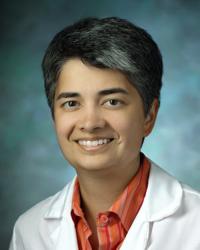Research Lab Results
-
Ken Hui Lab
The Hui lab performs basic, translational and clinical research on genetics and genomics of neurogastroenterological disorders.
-
Zhaozhu Qiu Laboratory
Ion channels are pore-forming membrane proteins gating the flow of ions across the cell membrane. Among their many functions, ion channels regulate cell volume, control epithelial fluid secretion, and generate the electrical impulses in our brain. The Qiu Lab employs a multi-disciplinary approach including high-throughput functional genomics, electrophysiology, biochemistry, and mouse genetics to discover novel ion channels and to elucidate their role in health and disease. -
Nisa Maruthur Lab
The Nisa Maruthur Lab studies primary care; individualized medicine for the prevention and treatment of type 2 diabetes and obesity; pharmacogenomics of type 2 diabetes; and comparative effectiveness.
-
Nauder Faraday Lab
The Nauder Faraday Lab investigates topics within perioperative genetic and molecular medicine. We explore thrombotic, bleeding and infectious surgical complications. Our goal is to uncover the molecular determinants of outcome in surgical patients, which will enable surgeons to better personalize a patient’s care in the perioperative period. Our team is funded by the National Institutes of Health to research platelet phenotypes, the pharmacogenomics of antiplatelet agents for preventing cardiovascular disease, and the genotypic determinants of aspirin response in high-risk families. -
Tamara O'Connor Lab
The O'Connor Lab studies the molecular basis of infectious disease using Legionella pneumophila pathogenesis as a model system. We are looking at the network of molecular interactions acting at the host-pathogen interface. Specifically, we use L. pneumophila pathogenesis to examine the numerous mechanisms by which an intracellular bacterial pathogen can establish infection, how it exploits host cell machinery to accomplish this, and how individual proteins and their component pathways coordinately contribute to disease. We are also studying the role of environmental hosts in the evolution of human pathogens. Using genetics and functional genomics, we compare and contrast the repertoires of virulence proteins required for growth in a broad assortment of hosts, how the network of molecular interactions differs between hosts, and the mechanisms by which L. pneumophila copes with this variation.
-
Salzberg Lab
Research in the Salzberg Lab focuses on the development of new computational methods for analysis of DNA from the latest sequencing technologies. Over the years, we have developed and applied software to many problems in gene finding, genome assembly, comparative genomics, evolutionary genomics and sequencing technology itself. Our current work emphasizes analysis of DNA and RNA sequenced with next-generation technology. -
Seth Blackshaw Lab
The Seth Blackshaw Lab uses functional genomics and proteomics to rapidly identify the molecular mechanisms that regulate cell specification and survival in both the retina and hypothalamus. We have profiled gene expression in both these tissues, from the start to the end of neurogenesis, characterizing the cellular expression patterns of more than 1,800 differentially expressed transcripts in both tissues. Working together with the lab of Heng Zhu in the Department of Pharmacology, we have also generated a protein microarray comprised of nearly 20,000 unique full-length human proteins, which we use to identify biochemical targets of developmentally important genes of interest. -
Philip Wong Lab
The Philip Wong Lab seeks to understand the molecular mechanisms and identification of new therapeutic targets of neurodegenerative diseases, particularly Alzheimer's disease (AD) and amyotrophic lateral sclerosis (ALS). Taking advantage of discoveries of genes linked to these diseases (mutant APP and PS in familial AD and mutant SOD1, dynactin p150glued ALS4and ALS2 in familial ALS), our laboratory is taking a molecular/cellular approach, including transgenic, gene targeting and RNAi strategies in mice, to develop models that facilitate our understanding of pathogenesis of disease and the identification and validation of novel targets for mechanism-based therapeutics. Significantly, these mouse models are instrumental for study of disease mechanisms, as well as for design and testing of therapeutic strategies for AD and ALS. -
Peisong Gao Lab
The Peisong Gao Lab’s major focus is to understand the immunological and genetic regulation of allergic diseases. We have been involved in the identification of the genetic basis for atopic dermatitis and eczema herpeticum (ADEH) as part of the NIH Atopic Dermatitis and Vaccinia Network-Clinical Studies Consortium. Major projects in the Gao Lab include immunogenetic analysis of human response to allergen, identification of candidate genes for specific immune responsiveness to cockroach allergen, and epigenetics of food allergy (FA).
-
Andrew McCallion Laboratory
The McCallion Laboratory studies the roles played by cis-regulatory elements (REs) in controlling the timing, location and levels of gene activation (transcription). Their immediate goal is to identify transcription factor binding sites (TFBS) combinations that can predict REs with cell-specific biological control--a first step in developing true regulatory lexicons. As a functional genetic laboratory, we develop and implement assays to rapidly determine the biological relevance of sequence elements within the human genome and the pathological relevance of variation therein. In recent years, we have developed a highly efficient reporter transgene system in zebrafish that can accurately evaluate the regulatory control of mammalian sequences, enabling characterization of reporter expression during development at a fraction of the cost of similar analyses in mice. We employ a range of strategies in model systems (zebrafish and mice), as well as analyses in the human population, to illuminate the genetic basis of disease processes. Our long-term objective is to use these approaches in contributing to improved diagnostic, prognostic and therapeutic strategies in patient care.

